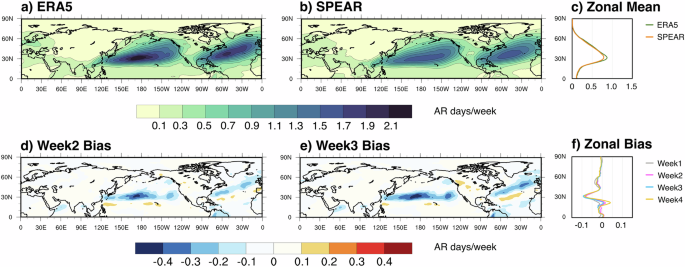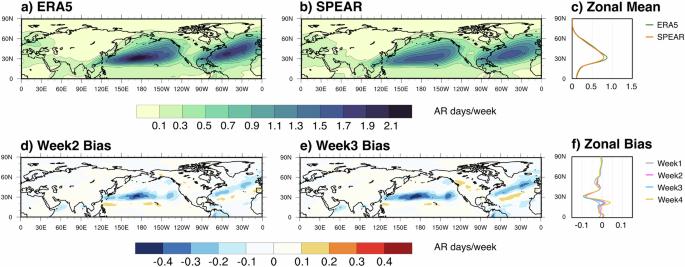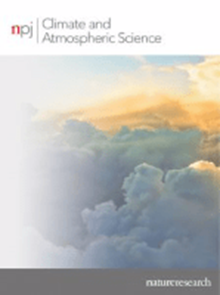Subseasonal-to-seasonal (S2S) prediction of atmospheric rivers in the Northern Winter
IF 8.5
1区 地球科学
Q1 METEOROLOGY & ATMOSPHERIC SCIENCES
引用次数: 0
Abstract
Atmospheric rivers (ARs) are characterized by intense lower tropospheric plumes of moisture transport that are frequently responsible for midlatitude wind and precipitation extremes. The prediction of ARs at subseasonal-to-seasonal (S2S) timescales is currently at a low level of skill, reflecting a need to improve our understanding of their underlying sources of predictability. Based on 20 year hindcast experiments from the Geophysical Fluid Dynamics Laboratory’s SPEAR S2S forecast system, we evaluate the S2S prediction skill of AR activities in the northern winter. Higher forecast skill is detected for high-frequency AR activities (3–7 days/week) compared to low-frequency AR activities (1–2 days/week), even though the occurrence rate of high-frequency ARs exceeds that of low-frequency ARs. For the first time, we have applied the Average Predictability Time technique to the SPEAR system to identify the three most predictable modes of AR in the North Pacific sector. These modes can be attributed to the influences of the El Niño–Southern Oscillation, the Pacific North American pattern, and the Arctic Oscillation. S2S AR forecast skill in western United States is modulated by various phases of large-scale variability. This study highlights potential windows of opportunity for operational S2S AR forecasting.


北方冬季大气河流的亚季节到季节(S2S)预测
大气河流(ARs)的特点是对流层下部强烈的水汽输送羽流,经常造成中纬度的极端风和降水。目前,亚季节到季节(S2S)时间尺度的大气河流预测技术水平较低,这反映出我们需要提高对其潜在可预测性来源的认识。根据地球物理流体动力学实验室 SPEAR S2S 预报系统的 20 年后测实验,我们评估了北方冬季 AR 活动的 S2S 预报技能。与低频 AR 活动(1-2 天/周)相比,高频 AR 活动(3-7 天/周)的预报技能更高,尽管高频 AR 的发生率超过了低频 AR。我们首次将平均可预测时间技术应用于 SPEAR 系统,以确定北太平洋扇区 AR 的三种最可预测模式。这些模式可归因于厄尔尼诺-南方涛动、北美太平洋模式和北极涛动的影响。美国西部的 S2S AR 预报技能受不同阶段大尺度变率的影响。这项研究强调了实用 S2S 变率预报的潜在机会窗口。
本文章由计算机程序翻译,如有差异,请以英文原文为准。
求助全文
约1分钟内获得全文
求助全文
来源期刊

npj Climate and Atmospheric Science
Earth and Planetary Sciences-Atmospheric Science
CiteScore
8.80
自引率
3.30%
发文量
87
审稿时长
21 weeks
期刊介绍:
npj Climate and Atmospheric Science is an open-access journal encompassing the relevant physical, chemical, and biological aspects of atmospheric and climate science. The journal places particular emphasis on regional studies that unveil new insights into specific localities, including examinations of local atmospheric composition, such as aerosols.
The range of topics covered by the journal includes climate dynamics, climate variability, weather and climate prediction, climate change, ocean dynamics, weather extremes, air pollution, atmospheric chemistry (including aerosols), the hydrological cycle, and atmosphere–ocean and atmosphere–land interactions. The journal welcomes studies employing a diverse array of methods, including numerical and statistical modeling, the development and application of in situ observational techniques, remote sensing, and the development or evaluation of new reanalyses.
 求助内容:
求助内容: 应助结果提醒方式:
应助结果提醒方式:


